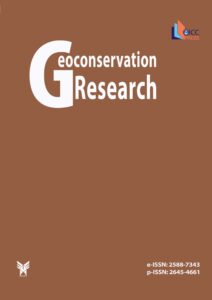Shifting Continents and a Devonian Lake Full of Fish: The Extraordinary Geological History of the Shetland Geopark
Authors
Abstract
Shetland UNESCO Global Geopark encompasses a wide variety of well-exposed and accessible geological features. The combination of ocean floor remnants on top of ancient continental crust, a cross-section through a volcano, and evidence of earth movements is preserved nowhere else in the world and, individually, are some of the best examples known. Devonian rocks deposited on the resulting landscape contain fossil faunas – vertebrate, invertebrate and plant – representing an early terrestrial ecosystem, elements of which have been correlated to similar Devonian deposits across northeast Scotland. Today, the Shetland UNESCO Global Geopark is managed by the Shetland Amenity Trust with the involvement of many organisations on and beyond the islands to conserve and promote exposures of the various geological features, now and into the future.
Read the full text of the articleKeywords
- Devonian fish
- Shetland Amenity Trust
- Geoconservation. Geotourism
- Shetland ophiolite
- Eshaness volcano
Main Subjects
References
Allen PA & Marshall JEA (1981). Depositional environments and palynology of the Devonian south-east Shetland basin. Scottish Journal of Geology. 17: 257–273.
British Geological Survey (2020). The BGS Lexicon of Named Rock Units [online]. Keyworth, Nottingham. Available from https://www.bgs.ac.uk/technologies/the-bgs-lexicon-of-named-rock-units/.
Bukała M, Zboińska K & Szadkowski M (2016). Troodos ophiolite mantle section exposed along Atalante Geo-Trail, Troodos Geopark, Cyprus. Geoscience Records. 3(1): 1–6.
Chaloner WG (1972). Devonian plants from Fair isle, Scotland. Review of Palaeobotany and Palynology. 14: 49–61.
Chen P-J & Morris S (1991). Ipsilonia – A Devonian conchostracan from Orkney, Scotland. Acta Palaeontologica Sinica. 30: 243–245.
Finlay TM (1926). The Old Red Sandstone of Shetland. Part 1. South-eastern area. Earth and Environmental Science Transactions of The Royal Society of Edinburgh. 54: 553–572.
Flinn D (1956). On the deformation of the Funzie conglomerate, Fetlar, Shetland. Journal of Geology. 64: 480–505.
Flinn D (1961). Continuation of the Great Glen fault beyond the Moray Firth. Nature London. 191: 589–591.
Flinn D (2014). Geology of Unst and Fetlar in Shetland. British Geological Survey. Edinburgh: HMSO for Institute of Geological Sciences.
Flinn D, Miller JA, Evans AL, Pringle IR (1968). On the age of the sediments and contemporaneous volcanic rocks of western Shetland. Scottish Journal of Geology, 4: 10–19.
Flinn D & Oglethorpe RJ (2005). A history of the Shetland Ophiolite Complex. Scottish Journal of Geology. 41: 141–148.
Gass IG (1980). The Troodos massif: Its role in the unravelling of the ophiolite problem and its significance in the understanding of constructive plate margin processes. In A. Panayiotou (Ed.), Ophiolites, Cyprus Geological Survey (pp. 23–35).
Hibbert S (1819-1820). Sketch of the distribution of rocks in Shetland. Edinburgh Philosophical Journal. 1: 296–314; 2: 67–79, 224–242.
Hibbert S (1822). Description of the Shetland Isles. Edinburgh.
Highton AJ and Wignall RML (2020) The Caledonian Structures of Shetland - Funzie and Norwick. Geological Conservation Review sites. Proceedings of the Geologists’ Association 132: 1–15.
Hooker JD (1853). Note on the fossil plants from the Shetlands. Quarterly Journal of the Geological Society of London. 9: 49–50.
Jameson R (1798). An Outline of the Mineralogy of the Shetland Islands: And of the Island of Arran. Edinburgh.
Lemon K, Barron HF& Gordon JE (2013). Scotland’s Geodiversity Charter: a step forward for Scottish Geoparks. 12th European Geoparks Conference. In Aloia, A, Calcatera, D, Cuomo, A, De Vita, A and Guida, D (Eds.), Proceedings of the 12th European Geoparks Conference (pp. 150–153). National Park of Cilento, Vallo di Alburni Geopark.
Miles RS & Westoll TS (1963). Two new genera of coccosteid Arthrodira from the Middle Old Red Sandstone of Scotland, and their stratigraphical distribution. Transactions of the Royal Society of Edinburgh. 65: 179–208.
Murchison RI (1853). Note on the Age and Relative Position of the Sandstone containing Fossil Plants at Lerwick in the Shetland Isles. Quarterly Journal of the Geological Society of London. 9: 50–51.
Mykura W, Flinn D & May F (1976). British regional geology: Orkney and Shetland (p. 149). Edinburgh: HMSO for Institute of Geological Sciences.
Mykura W and Phemister J (1976). Geology of Western Shetland. Edinburgh: HMSO for Institute of Geological Sciences.
Newman MJ and Den Blaauwen JL (2018). A redescription of the endemic antiarch placoderm Asterolepis thule from the Middle Devonian (Givetian) of Shetland and its biostratigraphical horizon. Scottish Journal of Geology. 54: 69–75.
Peach BN (1877). Notes on the fossil plants found in the Old Red Sandstone of Shetland, Orkney, Caithness, Sutherland and Forfarshire. Edinburgh Geological Society. 3: 148–152.
Peach BN & Horne J (1879). The glaciation of the Shetland Isles. Quarterly Journal of the Geological Society. 35: 778–811.
Shetland Amenity Trust website: https://www.shetlandamenity.org/geopark-shetland)
Shetland Tourism Strategy 2018-2023 (2018, October 30). Shetland Tourism Association. https://www.shetlandtourismassociation.org/strategy. Retrieved August 24, 2020.
Swartz BA (2009). Devonian actinopterygian phylogeny and evolution based on a redescription of Stegotrachelus finlayi. Zoological Journal of the Linnean Society. 156: 750-784.
Traquair RH (1908). On fossil fish remains from the Old Red Sandstone of Shetland. Transactions of the Royal Society of Edinburgh. 46: 321–329.
Trewin NH (1976). Correlation of the Achanarras and Sandwick Fish Beds, Middle Old Red Sandstone, Scotland. Scottish Journal of Geology. 12: 205–208.
Watson DMS (1932). On three new species of fish from the Old Red Sandstone of Orkney and Shetland. Memoirs of the Geological Survey of Great Britain, Summary of Progress for 1931. 2: 157–165.
Watson DMS (1934). Report of fossil fish from Sandness, Shetland. Memoirs of the Geological Survey of Great Britain, Summary of Progress for 1933. 1: 74–76.
Westoll TS (1937). The Old Red Sandstone fishes of the north of Scotland, particularly of Orkney and Shetland. Proceedings of the Geologists' Association. 48: 13–45.




